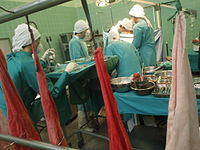
Photo from wikipedia
Donor safety is utmost important in Living donor liver transplantation (LDLT). Small for size syndrome in some recipients with left lobe donors led to the evolution of right lobe LDLT.… Click to show full abstract
Donor safety is utmost important in Living donor liver transplantation (LDLT). Small for size syndrome in some recipients with left lobe donors led to the evolution of right lobe LDLT. The aim of the study was to analyze the safety of large series of right lobe (RL) donor hepatectomies and compare outcomes with left lobe (LL) and left lateral segment (LLS) donations. A consecutive cohort of 726 donors from January 2011 to January 2014 were studied; RL (n = 641, 88.3%), LL (n = 36, 4.9%) or LLS (n = 49, 6.8%) depending on the type of donation. The mean age was 34.6 ± 10 years. The overall complication rate was 22.3%. Most were Clavien grade I and II. Clavien grade IIIa, IIIb, IV and V were noted in 4.2% donors. The incidence of these major complications were comparable among RL (n = 28, 4.2%), LL (n = 1, 2.7%) and LLS (n = 2, 4.08%) (P = 0.89). Bile leak was seen in 20 donors (2.7%) and 13 were managed conservatively with prolonged or additional intra‐abdominal drainage. Seven underwent re‐exploration for bile leak. In centres experienced in right lobe LDLT, morbidity after RL donation is similar to that of LL donation; and with adequate GRWR, same 1‐year recipient outcomes.
Journal Title: Transplant International
Year Published: 2018
Link to full text (if available)
Share on Social Media: Sign Up to like & get
recommendations!